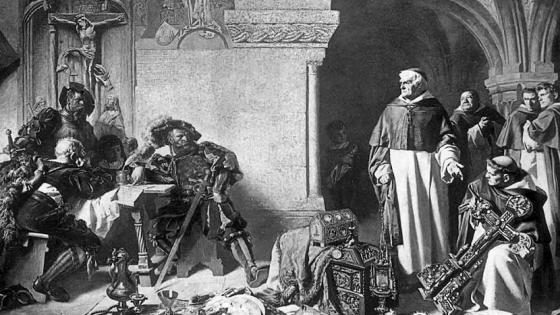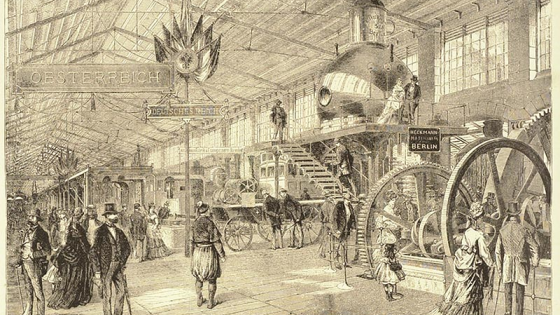Economists have long studied the causes of the Industrial Revolution, relying frequently on comparisons between England and other European countries to understand “Why England and not France or the Low Countries?”. Many hypotheses have been advanced – from the abundance of cheap fuel in the form of coal (Pomeranz 2000, Fernihough and O’Rourke 2014), to the effect of the slave trades (Williams 1944), to technological change inducing high wages (Allen 2009), to a series of institutional shocks leading to innovation and industrialisation (North and Thomas 1973, Acemoglu et al. 2005). In a recent paper, we test a subset of the main hypotheses about industrial success across 16,000 villages in England (Heldring et al. 2017). Aside from measuring a large number of geographical attributes of each village, we focus on a large shock that hit the English countryside in the mid 16th century – the Dissolution of the Monasteries. While in the previous literature the subject of study was essentially England versus the rest of the world, we can explain regional variation in industrial activity across England.
The Dissolution of the Monasteries
In 1534, Henry VIII decided to break with the Catholic Church. In addition to severing ties with Rome, Henry appropriated all taxes that monasteries, churches and other religious institutions paid to the Pope. When his financing needs – due to wars in France – became too great, he expropriated all monasteries in England, which collectively held about one third of all land in the country (Youings 1967). When the management of these vast properties turned out to outstrip the bureaucratic capacity of his government, Henry sold all monastic assets in England. The main effect of this dumping of land was the creation of local land markets. Where lands were before held in long leases whose rates were set by medieval custom, lands now changed hands frequently and at market rates. In a few years between 1535 and 1542, the majority of monastic land was sold. Since monastic holdings were often ancient and were spread out unevenly throughout England, villages were differentially impacted by this shock. Some villages had no monastic assets in them (monasteries often owned land far away from their physical buildings) whereas in others, a local – or distant – monastery may have held large tracts of land. We hypothesise that the creation of a land market can be linked to local differences in subsequent development and, ultimately, industrialisation.
Industrialisation across English villages
We compare villages impacted more by the Dissolution to villages that were impacted less. We choose comparison villages that lie close to impacted villages so as to make them comparable. When we statistically estimate the effect of having more monastic assets in a village in 1535 on industrialisation, we find a large positive effect – villages that had more monastic assets (by value) were more likely to have at least one textile mill by 1836 and employed more people in the textile industry.
Our set up allows us to test the effect of the Dissolution relative to other hypotheses, such as posited positive effects of proximity to coal or rapidly flowing rivers, access to harbours and the sea, or productivity of the soil. Most importantly, we can measure pre-Dissolution differences in prosperity through a large tax census that was carried out in the mid-1520s a few years before the Dissolution. When we compare the effect of these factors to the effect of the Dissolution, we find that the effect of the Dissolution on industrialisation is more important than any of the competing hypotheses.
Why the Dissolution affected industrialisation
The historical consensus on the immediate impact of the Dissolution was to break up archaic forms of land tenure and create a land market (Youings 1967, 1971). We test for the immediate implications of this hypothesis by studying how the Dissolution impacted division of labour, productivity, and innovation. In addition, we test the well-known hypothesis that the Dissolution led to the rise of a middle class which – by the time of the Industrial Revolution – was active as financiers of industry and as advocates of industrialisation through parliament.
We find evidence for several mechanisms that transmit the impact of the Dissolution to the development of industry.
- Division of labour. In 1831, villages that had more monastic assets have a significantly smaller share of the population active in agriculture and a large share in manufacturing.
- Productivity. Parishes impacted more by the Dissolution had higher productivity in agriculture in the early 19th century.
- Innovation. Individuals who filed agricultural patents between 1700 and 1850 were disproportionally more likely to live in with more monastic assets. These parishes are also more likely have property rights assigned to common lands (in other words, they were ‘enclosed’).
In addition, we test for the ‘Rise of the Gentry’ (Tawney 1941), and find that before the start of the Industrial Revolution in 1680, parishes with more monastic assets were more likely to be home to members of the gentry – the upwardly mobile commercial middle class intimately associated with industrialisation.
Conclusion
The Dissolution created a land market and started the modernisation of land tenure relationships. This led to division of labour, innovation, greater productivity, rationalisation of property rights, and changes in social structure. Ultimately, these factors coalesced into industrialisation in those places where the monasteries held lands centuries before the Industrial Revolution. The institutional change driven by the Dissolution is a more important driver of local industrialisation than commonly used explanations – such as local abundance of coal.
References
Acemoglu, D, S Johnson, and J A Robinson (2005), “The Rise of Europe: Atlantic Trade, Institutional Change and Economic Growth”, American Economic Review 95: 546-579.
Allen, R C (2009), The British Industrial Revolution in Global Perspective, New York: Cambridge University Press.
Fernihough, A, and K H O'Rourke (2014), “Coal and the European Industrial Revolution”, NBER Working Paper no. 19802.
Heldring, L, J A Robinson, and S Vollmer (2017), “Monks, Gents and Industrialists: The Long-Run Impact of the Dissolution of the English Monasteries”, NBER Working Paper no. 21450.
North, D C, and R P Thomas (1973), The Rise of the Western World: A New Economic History, Cambridge University Press.
Pomeranz, K (2000), The Great Divergence, Princeton University Press.
Tawney, R H (1941), “The Rise of the Gentry”, Economic History Review 11(1): 1-38.
Williams, E (1944), Capitalism and Slavery, University of North Carolina Press.
Youings, J A (1967), “The church”, in J Thirsk (ed.), The Agrarian History of England and Wales, Volume 4, 1500-1640, Cambridge University Press.
Youings, J A (1971), The Dissolution of the Monasteries, Allen and Unwin.



